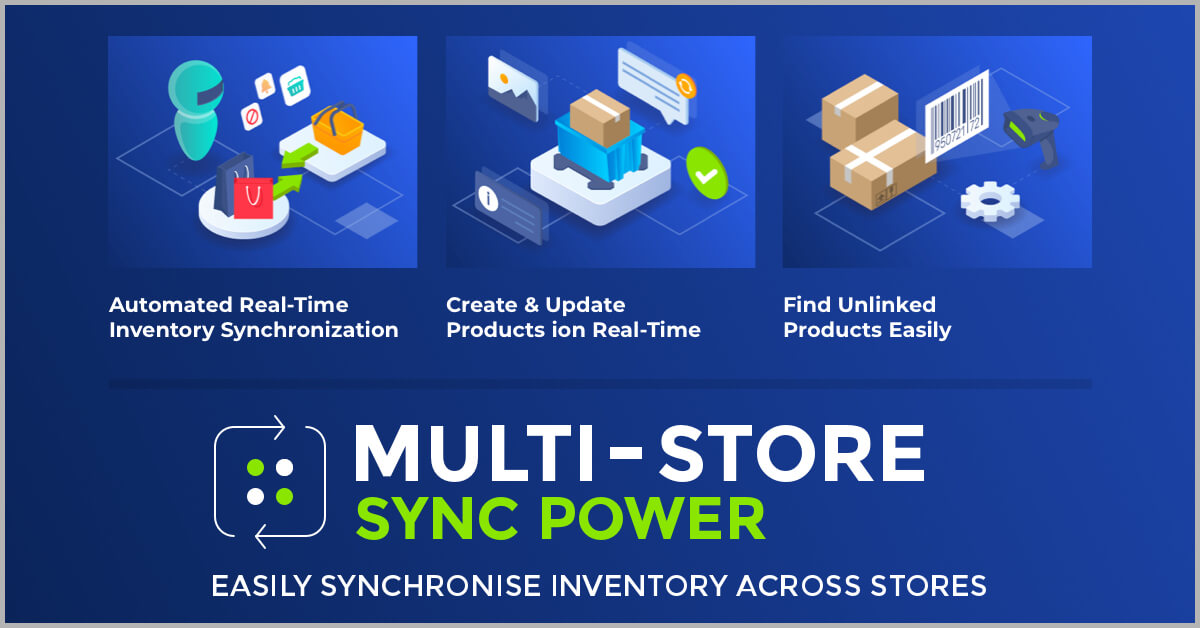Can You Have Multiple Shopify Stores?
Published June 25, 2024.

Selling on multiple Shopify stores isn’t for everyone. For many merchants, it makes sense to sell only through a single online store.
But once you reach a certain point and things are running smoothly, you may be tempted to explore new ways to extend your reach. Starting from a small one-region store to serving new markets and growing your profits using multiple Shopify stores.
Can You Have Multiple Shopify Stores?
You can have as many e-commerce stores on Shopify as you are willing to run.
Can You Make Multiple Shopify Stores on One Account?
The short answer is no. Each store requires a separate plan and is managed through a different dedicated account. The slightly longer answer is that you can use one email address to sign up for multiple Shopify accounts. When you log in, you enter your store’s domain name, not just the email.
Using one email address for different accounts lets you have all your communications sent to the same place. However, you will need to log in to each account separately.
Do You Need Multiple Shopify Stores?
It’s an easy question to ask, but the answer isn’t always clear. More stores mean more work.
You Want to Reach New Demographics
Managing multiple stores lets you aim your marketing messages at distinct market segments. If you’re selling a range of products that might appeal to multiple market segments, then running multiple stores lets you cut across the clutter and attract more sales.
You're Selling to Multiple Countries
Your stats show that you are getting a good number of dedicated repeat customers from a country outside your primary target area. These customers are buying high-priced items or buying high enough volume to turn into a significant profit. Separate stores would do a good job in this case.
You Want to Speak Their Language
It pays to have your content available in the languages your customers are familiar with. Getting this right is the difference between pushing away potential new customers and gaining a piece of the market share.
You Want to Use Their Currency
Most customers don’t want to deal with messy conversion rates and the potential for fees. So offering prices in local currency can increase your sales.
You Want to Reach New Audience
Are you targeting specific buyers using PPC or CPM advertising on Google or Facebook? Setting up multiple Shopify stores lets you target your ads to these buyers and send them to a localized shop.
You're Selling at Multiple Price Points
If you offer high-price items next to low-cost products on your main store, you risk devaluing your brand in your audience’s eyes. With multiple Shopify stores, you can use them as separate sales channels. Use one to sell full-priced items and another to sell your products at a discount. Or use one for individual sales and another for bulk or wholesale deals.
If you’ve decided that opening multiple Shopify stores is right for you, there are still a few challenges ahead.
Challenges in Managing Multiple Stores
Updating Your Catalog
With multiple Shopify stores, you’ll have multiple sets of inventory. If your stores only have a few SKUs, there is no problem. However, if you rotate your stock range regularly or have a broad product range, this could mean a lot more work.
Monitoring Your Inventory
With more sites, you have more stock levels to keep track of. If you make a sale on Site A, then Site A’s inventory count goes down. But Site B won’t track this change, which could lead you to overselling products.
Managing Fulfillment and Returns
Any sales made need to be processed and tracked promptly, with the correct receipts and contact details. The same is true when a customer returns a product. Making sure the right product (or refund) goes to the right customer is crucial.
If these challenges sound like they’re worth tackling, you may be ready to set up your new Shopify store.
How to Create Multiple Shopify Stores?
Assuming you already have a Shopify store up and running, the process of expansion is relatively simple.
Get a New Shopify Account
It might help to register your stores with the region or market you’re focusing on in the Shopify store name. For example, if your current shop is “store.myShopify.com“, and you want to focus on selling to the UK, you could register “store-uk.myShopify.com“.
Setup a New Domain
You have two main options – use a separate domain or use a sub-domain. Different domains let you “brand” the shopping experience using top-level domains. This may cost a little extra, and in some countries may require you to have a business registered with the authorities.
Sub-domains let you take advantage of your “main” site’s address by extending the domain. Using this approach also helps reassure customers that the domain is a legitimate extension of your brand.
Duplicate Your Shop
This part is quite involved, and it will take a bit of effort, but you can take your time with each section before moving on.
- Copy your theme. In Shopify, go to Admin > Themes and click “Export Theme“. Download the file and upload it to your new store.
- Duplicate your product data. Go to Admin > Products, click “Export“, then “Export All“. Download the CSV and upload it to your new store.
- Migrate page content.
- Open the two sites in separate windows.
- Click on Pages, and for each page, copy the HTML from your original store and paste it into the new site. This will ensure the pages look the same.
- Open the “theme.liquid” file for both stores and add “hreflang” tags to the <head> sections in both. This tag stops your stores from being penalized in search rankings for duplicate content. In-depth details on this step are available on Google Support.
- Localize your links. Whenever possible, it’s best to use relative URLs for internal links. Just set the link as “/contact” instead of “yourstore.com/contact“.
- Re-install your apps. Install and configure the apps you know you’ll need in your new shop. You may want to consider adding a redirect to detect your visitors’ location and point them to the right shop.
- Set up your payment gateways.
- Add Google Analytics. You will want this so you can track your shop’s performance once it goes live.
Localize Your Content
If you’re using your new multiple shops to sell globally, now is the time to update content for your international customers. This way they can enjoy an experience that still feels familiar. Luckily, Shopify has put a lot of work into serving these merchants. Shopify supports 113 global currencies in Shopify Payments which helps with transparent pricing for your international customers.
How to Run Multiple Shopify Stores?
Now that your stores are successfully set up, it’s time to tackle the management side of selling through multiple Shopify stores.
Standardize Your Product Data Using a Product Information Management System (PIM)
If your product data is structured differently across each of your Shopify stores, it can take time and effort to sync these details. Without a standardized data structure, you are running your stores with potentially messy or inaccurate data. This can put off customers and slow down order fulfillment for those who do choose to buy.
Managing different sales channels, stores, and data sets can require different techniques or tools. It takes up even more time and can be quite frustrating.
Instead, it’s easier to use a product information management (PIM) system to centralize and standardize your product data before it gets pushed out to your stores. A PIM system tracks all the information that’s managed by your business and distributes it across all your channels effectively, ultimately resulting in unified information that’s updated in real-time.
Centralizing Your Order Management
Depending on your email client, you can set up sorting rules. They will forward sales and return emails from different stores to dedicated inboxes. You can take it a step further and automatically forward these orders and returns to specific addresses.
This helps to designate certain actions to specific employees. These sorting rules are available in Microsoft Outlook, Google Gmail, and Mozilla Thunderbird, amongst others.
Unify Your Customer Support
Keeping track of customer support in a multi-store setup can get complicated fast. This is especially the case if you localize your customer support for customers based on demographics.
A unified customer support system keeps all your customer queries and order management details in one central inbox. Luckily, Shopify has a lot of professional tips on how to provide professional customer support.
Centralize Your Inventory
Without an inventory management system, you run the risk of overselling your products. To manage multiple Shopify stores effectively, you need a centralized view of what’s happening with inventory levels.
The best way to do this is to use an inventory management system. It will aggregate your data across your stores to a centralized system capable of managing orders across all online sites. Egnition’s own Multi-Store Sync Power does this by synchronizing inventory and product data across all connected Shopify stores.
Simplifying Product Management
With two or more Shopify stores, it’s quickly going to become difficult to manage updates to your products. If you’re localizing prices by region, selling off-price items through a dedicated store, or making bundles available to a specific target market, then this work will quickly multiply out of control.
Once again, Sync Power can give you a way to manage inventory from a central point. This two-way sync lets you update inventory and products data including localized currencies from a central location – with all the changes pushed live across your stores according to your needs.
You can also try our other apps for managing products. For example, Out-of-Stock Police – it will push sold out items down or hide products when out-of-stock.
Go Forth and Conquer!
If you’ve followed the details in this article, your new shops should be mostly set up. Once you set up your IP redirects app, you can activate your advertising campaigns, send off your email blasts, and start directing traffic between your multiple shops.
Managing multiple Shopify stores can involve more work. But they offer the opportunity to grow profits by reaching new markets. And with processes mentioned here, you’ll be able to conquer many of the common challenges. It’s time to take full advantage of running multiple Shopify stores.






